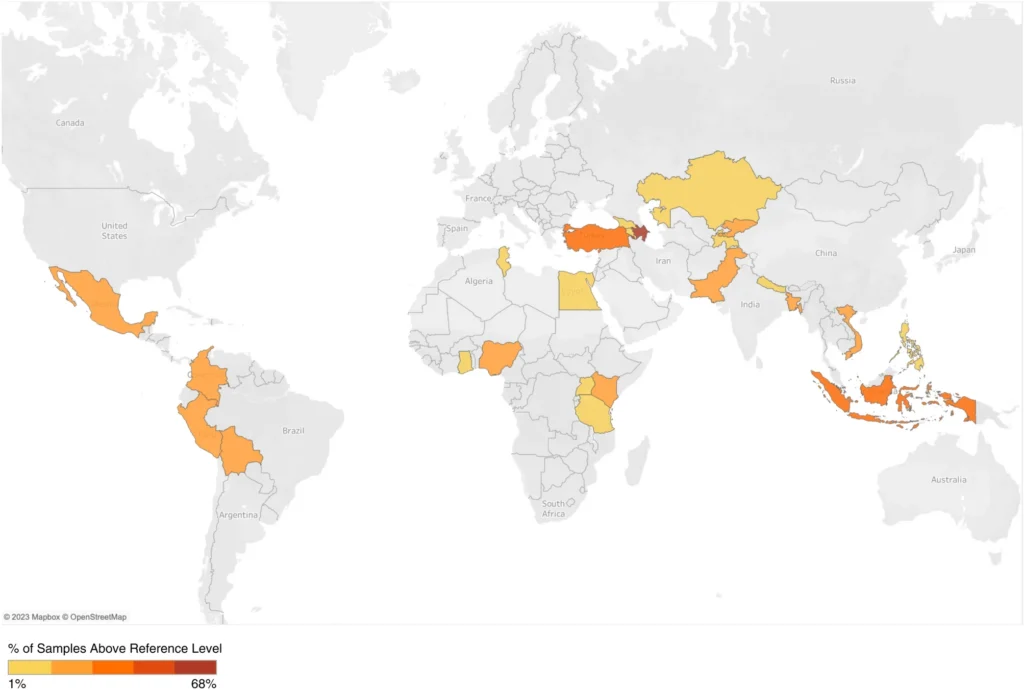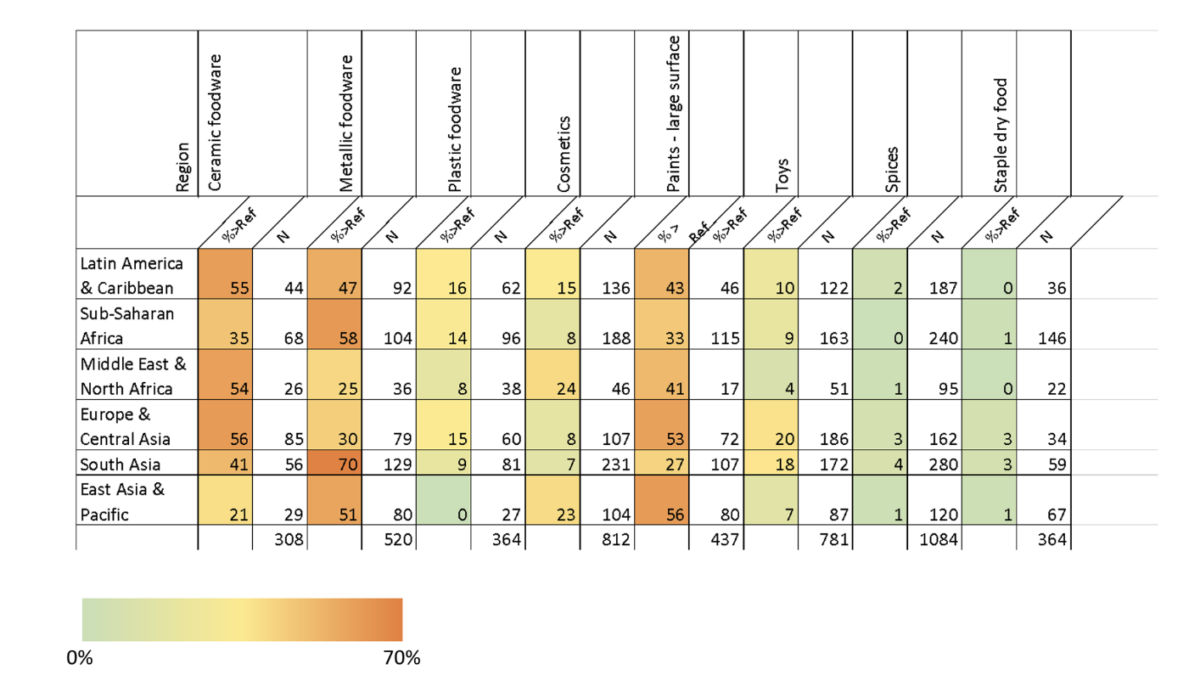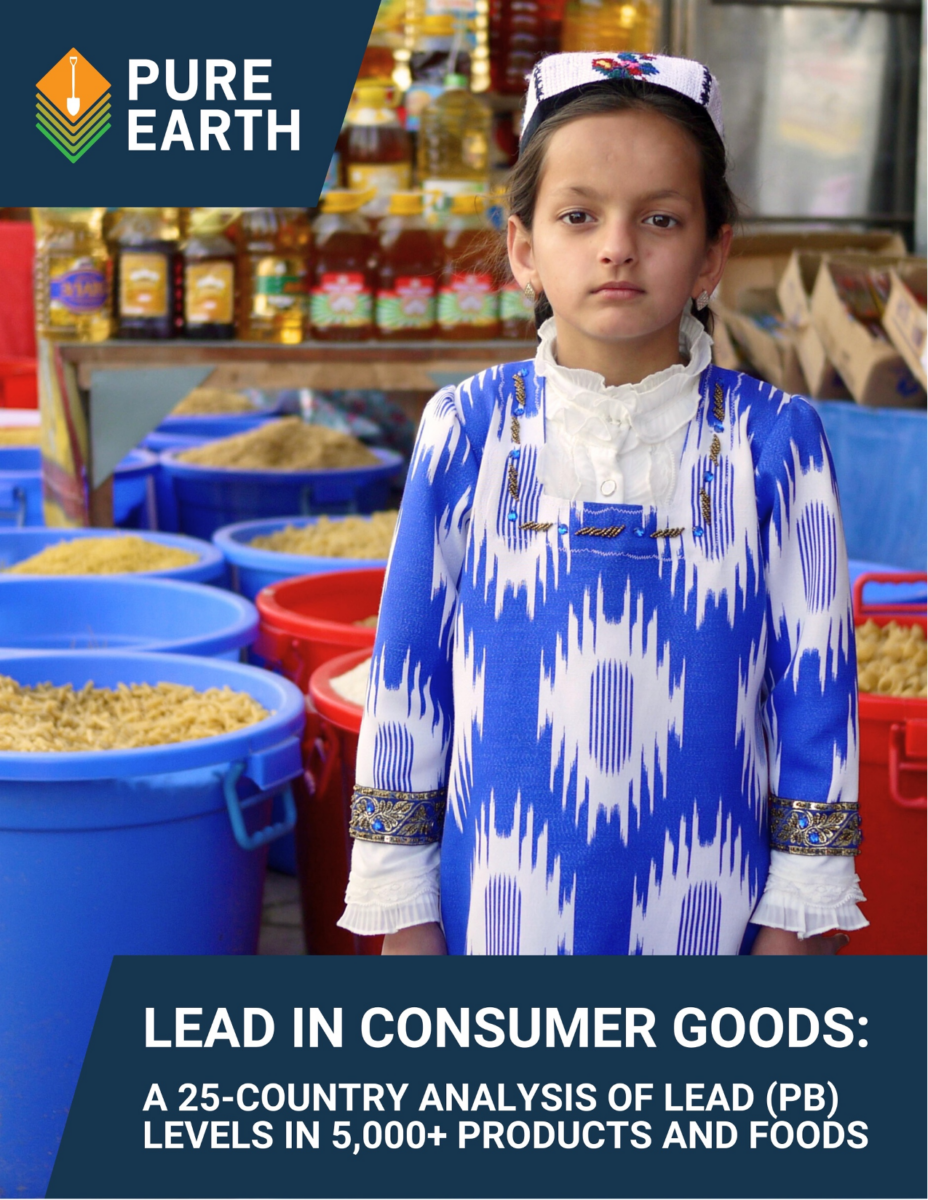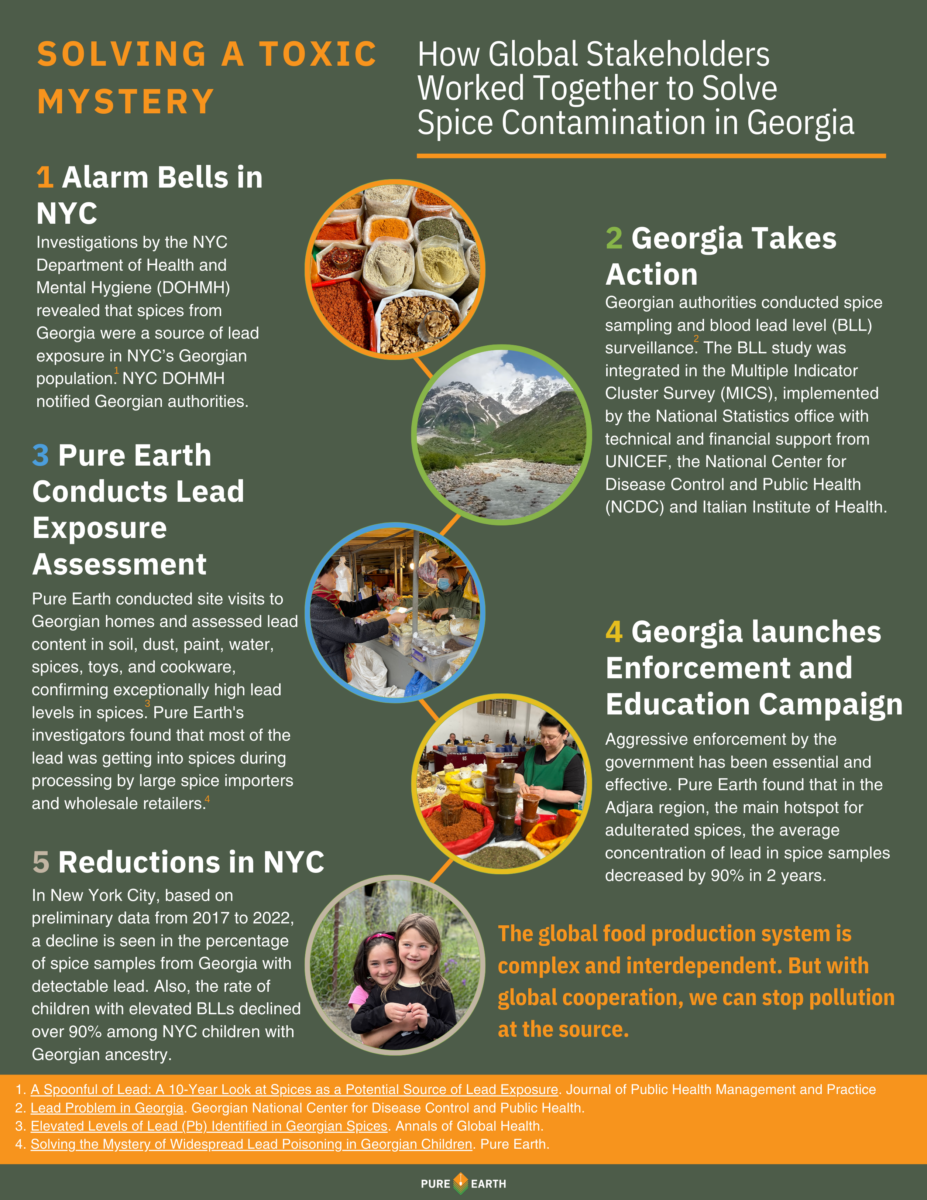In 2021, Pure Earth launched an ambitious project to analyze lead contamination in thousands of products and food samples in markets across 25 low- and middle-income countries.
While prior studies have identified lead contamination in a variety of consumer goods, the geographic variations in lead exposure sources have been poorly understood. The Rapid Market Screening (RMS) project is the first analysis of its kind that we are aware of.
Support for this project comes from Open Philanthropy, the Effective Altruism Global Health and Development Fund, and GiveWell.
Rapid Market Screening Findings Published in Scientific Reports
Rapid Market Screening to assess lead concentrations in consumer products across 25 low- and middle-income countries
Scientific Reports volume 14, Article number: 9713; Published: April 27, 2024
Lead exposure can have serious consequences for health and development. The neurological and behavioral effects of lead are considered irreversible. Young children are particularly vulnerable to lead poisoning. In 2020, Pure Earth and UNICEF estimated that one in three children had elevated blood lead levels above 5 µg/dL. The sources of lead exposure vary around the world and can range from household products, such as spices or foodware, to environmental pollution from nearby industries.
The aim of this study was to analyze common products from markets in low- and middle-income countries (LMICs) for their lead content to determine whether they are plausible sources of exposure. In 25 LMICs, the research teams systematically collected consumer products (metal foodware, ceramics, cosmetics, paints, toys, spices and other foods). The items were analyzed on site for detectable lead above 2 ppm using an X-ray fluorescence analyzer. For quality control purposes, a subset of the samples was analyzed in the USA using inductively coupled plasma mass spectrometry. The lead concentrations of the individual product types were compared with established regulatory thresholds.
The RMS was implemented in the following 25 countries and states: Armenia; Azerbaijan; Bangladesh; Bolivia; Colombia; Egypt; Georgia; Ghana; the Indian states of Maharashtra, Tamil Nadu, and Uttar Pradesh; Indonesia; Kazakhstan; Kenya; Kyrgyzstan; Mexico; Nepal; Nigeria; Pakistan; Peru; the Philippines; Tajikistan; Tanzania; Tunisia; Türkiye; Uganda; and Vietnam.
Key Findings
Across the 5,007 samples collected in 25 countries, 18% were lead contaminated at levels that exceed relevant reference levels.
The product types that most frequently exceeded relevant public health guidelines or regulatory limits were: metal foodware (51% of samples exceeded the threshold of 100 ppm), ceramics (45% exceeded the threshold of 100 ppm), and paints (41% exceeded the threshold of 90 ppm).
Sources of exposure in LMICs can be diverse, and consumers in LMICs lack adequate protection from preventable sources of lead exposure. The Rapid Market Screening is an innovative, simple, and useful tool to identify risky products that could be sources of lead exposure.

Results by Product Type
Across all 5,007 samples collected, 18% were lead contaminated at levels that exceed relevant reference levels.
Results by Region
This table shows the distribution of lead concentrations and the distribution of highly lead-tainted samples above the reference level analyzed by region.
The results are in ppm lead. Only product types with sufficient numbers of samples are shown.
White Paper Detailing Results of RMS Program (Published September 2023)
Key Recommendations
Pure Earth’s seven-point action plan to address lead contamination in countries with high levels of contaminated products.
Blood lead level testing
Few low- and middle-income countries conduct large surveys or ongoing monitoring of children’s blood lead levels. The result is that we have little visibility into the prevalence, severity, and geographic distribution of lead poisoning for most countries. This is one of the largest impediments to solutions. Governments and their development partners should explore and invest in ways to generate primary data on children’s blood lead levels so resources can be allocated appropriately, and so progress can be measured. The importance of blood lead level surveillance testing is highlighted by the identification of widespread lead exposure sources in low- and middle income-countries as part of the RMS.
Home-Based Source Assessments
Blood lead level surveys should be conducted in conjunction with in-home source analyses to establish connections between contaminated products and actual incidents of lead poisoning. During home-based source assessments, investigators asses a variety of products and environmental media in and around the homes of children with elevated blood lead levels. This combination of blood lead level testing with in-home source analysis can point to correlations between elevated blood lead levels and the presence of contaminated products like those highlighted in the RMS to help identify potentially significant local contributors to lead poisoning.
Research into foodware leachability and use
The high prevalence and wide geographic distribution of contaminated metallic and ceramic foodware was a surprise to Pure Earth’s team. However, total lead levels in foodware, as measured in the RMS, provide only limited insights into the potential dangers from use. Total lead levels cannot yet tell us concretely what lead dose a person is likely to receive from each use of a pot or pan. While Pure Earth is conducting ongoing leachate testing of more than 100 aluminum pots to help answer these questions, field research is also needed to determine if lead contaminated foodware is used in settings where high concentrations of children could be exposed (e.g., schools, daycares, hospitals) and if the food prepared in such foodware is being contaminated. If contaminated foodware is used in settings with high concentrations of children and the food prepared in that foodware is becoming contaminated, interventions to replace contaminated foodware at these locations could be highly impactful at a relatively low cost.Given the extraordinary prevalence of contaminated metal foodware, research is needed to determine if there are ways to reduce the leachability of lead from metallic pots during or after production through the introduction of an additive, coating, or other means.
Establishing recommended limits for total lead in foodware
The RMS team did not find public health guidelines or regulatory standards for total lead concentrations in foodware from which to set reference levels. Instead, the RMS team created the reference level of 100 parts per million for foodware based on guidelines for other products and on Pure Earth’s ongoing research into foodware leachability. While some countries have limits for leachable lead in foodware, assessing the leachability of lead in a product generally requires a lab, which makes screening expensive and time consuming. Instead of establishing leachability limits, regulators should consider setting a maximum allowable concentration for total lead at the lowest achievable level. If exceptions are needed, regulations should force producers to demonstrate that products exceeding the allowable level would not leach lead into food under any condition.
Track cosmetics to production sources
There is a need to track commonly contaminated cosmetics to their production facilities and then work with governments and producers to eliminate lead use. Contaminated eyeliners, for example, can be bought through e-commerce retailers worldwide. Efforts to eliminate lead in such products could have global impacts.
Enact and enforce lead paint laws
All governments should enact and enforce regulations limiting lead in paint and consider guidance provided in the UNEP Model Law And Guidance for Regulating Lead Paint developed by the Global Alliance to Eliminate Lead Paint. Additionally, countries and their development partners should invest in monitoring and enforcement capacities to ensure strict regulatory compliance, taking into consideration the UNEP Lead Paint Law Compliance and Enforcement Guidance.
Replicate programs to eradicate spice adulteration
Successful efforts to stop the adulteration of spices with lead-based pigments in Bangladesh and Georgia should be adapted to other countries with similar challenges, particularly Northern India and Pakistan, where recent assessments suggest a pattern of adulteration.
Health Surveillance and Source Analyses
In addition to Rapid Market Screenings, several Pure Earth country offices are conducting blood lead level (BLL) studies and home-based assessments to determine potential sources of lead poisoning.
Learn more about this work in Bangladesh and in the Philippines.






